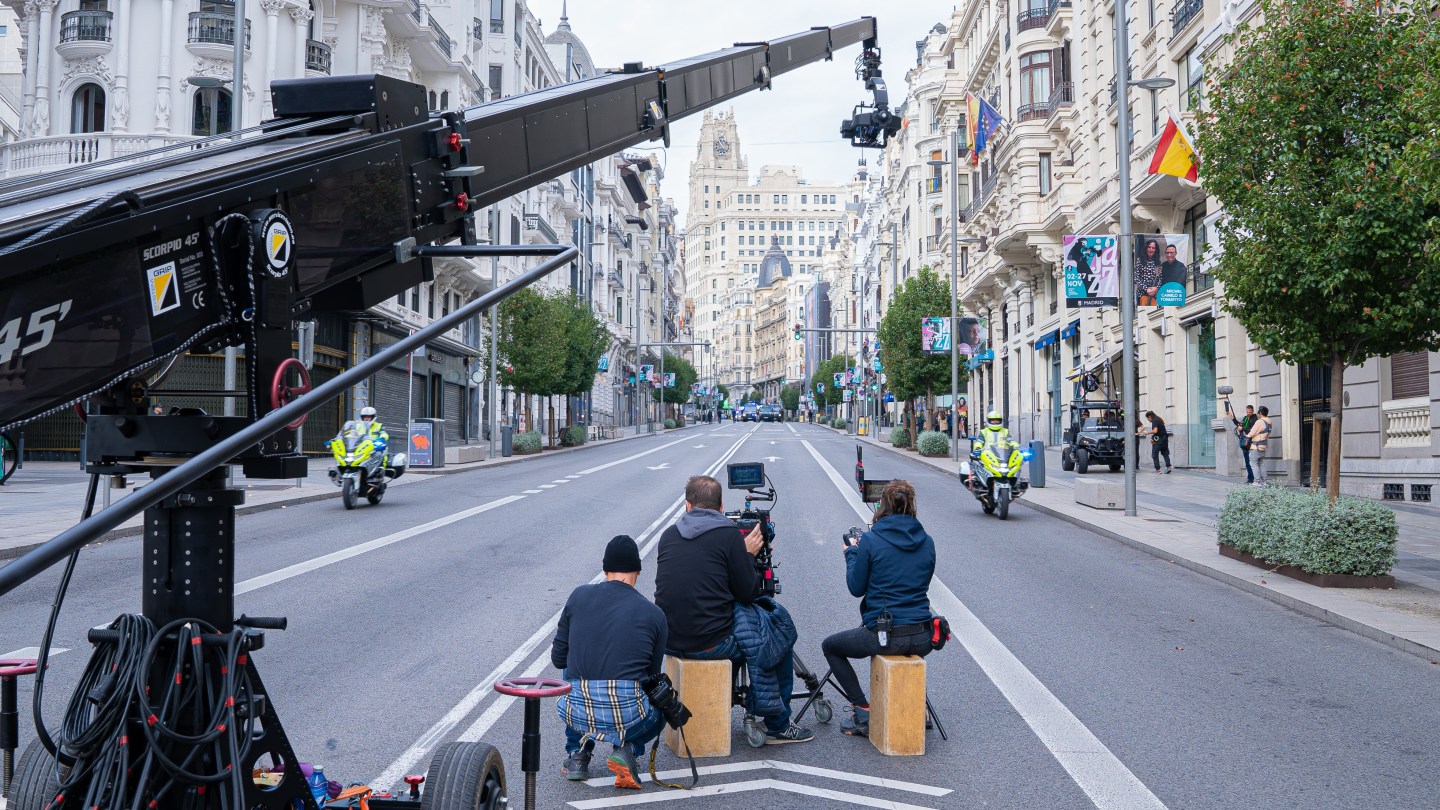The recent fourth edition of Iberseries & Platino Industria attracted Spanish- and Portuguese-language content creators and executives from Europe, Latin America, and the U.S. to Spain’s capital, Madrid.
Its market featured a range of booths, including one for the Madrid Film Office, whose mission is to promote the city as a filming destination, offer advice to TV, film, and other projects shooting in the city, and support the local industry and stimulate investment.
During Iberseries, The Hollywood Reporter caught up with Raúl Torquemada, director of the Madrid Film Office, to discuss his team’s success in attracting a broad range of productions beyond the ones you may immediately think of (Netflix’s Money Heist, anyone?), breaking records, and promoting the city via such offerings as a map about “Madrid, the TV Series Capital” and one showcasing 272 locations from Spanish auteur Pedro Almodóvar movies.
Why has Madrid been so successful in attracting film and TV shoots and companies?
I believe that the attractiveness of Madrid lies in the confluence of a series of factors. It has a solid audiovisual industry with top-level qualified professionals. It brings together 29 percent of the total active companies dedicated to audiovisual activities in Spain, including the biggest ones [with 73 percent of the total revenue] and 45 percent of its professionals. This means that Madrid offers national and international production companies a solid industrial fabric in which they can find all the suppliers, production services, and professionals they need to carry out projects of any size, without having to bring them from other territories. In addition, it offers it at more competitive prices than those of other capitals or important cities in Europe.
Second, it has a great climate and a great variety and versatility of locations, [with a] wide range of temperatures and more than 3,200 hours of sunshine per year that allow you to enjoy Madrid’s famous blue skies — something it shares with other regions of Spain, but distinguishes it from other cities in Europe. It has urban, natural, heritage locations — in the city and in the region, with spaces such as high mountains or desert areas at a maximum distance of 1 hour from the center of Madrid, which allows designing an efficient filming plan from a logistical point of view. Furthermore, the city has been used to recreate other cities, such as Buenos Aires, Mexico City, Paris, Berlin, or New York, which allows a wide range of stories to be located in Madrid. So, let’s say that you can find it all in Madrid: equipment, professionals, locations.
Third, added to all this, without a doubt, you can find institutional support in the form of incentives, aids, and support from the administration.

Madrid filming for Netflix series Berlin.
Courtesy of Netflix/Carla Oset/Madrid Film Office
But, above all this, one of the advantages that Madrid currently has is that it has already demonstrated precisely that all these factors work. That Madrid talent generates works of global interest and prestige, from hits such as the series La casa de papel (Money Heist) to films recognized at festivals, such as Volveráis (The Other Way Around) by Jonás Trueba, which won the award for best European film at the Cannes Directors’ Fortnight. That [means] international productions can find in Madrid an ideal filming set to develop projects that take place here, but also in other places. These months, part of the third season of a spin-off of The Walking Dead [The Walking Dead: Daryl Dixon] is being filmed in Madrid.
How important are financial incentives and qualitative support of creatives and productions and what key role does the Madrid Film Office play here?
Of course, incentives are another factor in promoting filming in Madrid, which adds to its competitiveness, talent and attractiveness. And also post-production, since in Madrid we have some of the leading companies in the sector worldwide, such as El Ranchito. And it is a factor that the Spain Film Commission, Profilm, and other entities always work to improve.
But I would also like to highlight that Madrid has its own subsidies for the production and promotion of audiovisual projects. Not only the region, as is usual, but the city of Madrid has had an important line of subsidies since 2021, which is more exceptional and demonstrates the city council’s commitment to the sector.
The subsidy has an annual budget of 3 million euros ($3.3 million), and in the last three years, it has promoted the production of 93 projects and the promotion of another 48 titles.
In addition, they are grants where the projects have to be linked in some way with Madrid, but they are very flexible in their criteria, which seeks to promote co-production and relationships with other national and international industries.
Added to all this, of course, is the institutional support through the Madrid Film Office to facilitate, among other things, that the projects can be developed in the best possible way in the city.
Is there any part of the audiovisual industry that Madrid would like to attract more?
The part in which the Madrid industry has grown the most in recent years has been in the production of series for platforms. But at the Madrid Film Office, we work to try to cover all subsectors and categories of productions, from large feature films or international series to independent Madrid productions, including advertisements, video clips, etc.

Raúl Torquemada, director of the Madrid Film Office
Courtesy of Madrid Film Office
Is there much competition with Barcelona and other parts of Spain?
I wouldn’t approach it as a competition situation. Of course, Madrid is interested in maintaining its leading position as a center of audiovisual production and development in Spain, working to continue growing in a sustainable and resilient way.
But we are at a very interesting moment for the Spanish audiovisual industry as a whole, with constant growth, and we work together outwardly with other territories to continue growing as a country and industry.
What are some of the key numbers Madrid has hit in terms of TV and film productions in recent years? Any records? And any anecdotes on how the film office has made something impossible happen?
In recent years, Madrid has grown a lot as a filming location and production center. This increase in filming has led to several records being broken, with 68 series filmed in the same year in 2021, and 47 films in 2022. In 2023, the city hosted 41 films, 55 series, and more than 410 advertisements.
It is also interesting to highlight the growing importance of co-productions in the sector. In 2023, almost 50 percent of the feature films shot in the city were international co-productions, many of them with Ibero-American countries. Three of the series filmed in Madrid were also co-produced last year and six in 2022.
This demonstrates the importance of international co-production in the audiovisual sector, by allowing the sharing of creative, technical, and economic resources to develop a project, and promoting collaboration, the exchange of knowledge, and the development of cultural links between different countries.

Madrid filming for Vix+’s Montecristo.
Courtesy of Secuoya Studios/William Levy Entertainment/Juan Carlos Lucas/Madrid Film Office
Precisely to promote co-production, the City Council supports, via the Madrid Film Office, the celebration of markets and events, such as Iberseries & Platino Industria or the Platinum Ibero-American Cinema Awards, which seek to celebrate and establish synergies between Ibero-American industries.
Any key projects worth highlighting?
Madrid Film Office has helped projects of all types and sizes. But we can highlight, for example, Terminator: Dark Fate, where an extensive intervention was carried out so that several streets in Madrid simulated Mexico City; Way Down, which required the complete closure of the area around Plaza de Cibeles, the central node of the city, on a Sunday; All the Names of God, for which the complete [shoot] was carried out for two days on Gran Vía, the main avenue that crosses the city; the series Warrior Nun and 30 Coins, whose filming took place in spaces of great heritage protection, such as the Temple of Debod and the Prado Museum.
I saw you even have a map online about where certain films and series were filmed etc...
At the Madrid Film Office, we also work a lot to promote the city as a destination for screen tourism. Every year, we develop several products and actions aimed at this. For example, this year we have published the map “El Madrid de Concha Velasco,” a tour of the city through the life and work of one of the most recognized actresses in our country.
We have also sponsored the map “Madrid, chica Almodóvar,” which includes 272 locations of the 23 films by the director. We have supported the expo of the same name that is taking place at the Conde Duque Cultural Center. And we have sponsored the publication of an informative book on the use and representation of Madrid spaces in cinema this last century.

Part of the Madrid map of Pedro Almodóvar film locations
Courtesy of Madrid Film Office









